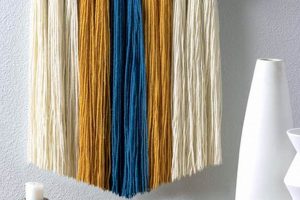A self-assembled decorative panel featuring preserved moss, commonly mounted on interior walls, offers a unique aesthetic element. These botanical installations provide a textured, natural surface, often constructed by individuals using readily available materials and techniques. For example, a wood frame, adhesive, and a variety of preserved mosses are typically utilized in the creation of this type of vertical garden.
Such green installations offer several advantages, including biophilic design elements that connect interior spaces with nature. The visual appeal of these walls can enhance environments by reducing stress and promoting a sense of tranquility. Historically, vertical gardens have been employed for aesthetic and practical purposes, and the modern application of preserved moss carries forward this tradition, offering a low-maintenance, long-lasting alternative to living walls.
The following sections will address the constituent materials, assembly procedures, maintenance requirements, and design considerations involved in the creation of these decorative features, providing a comprehensive guide for constructing similar botanical artwork.
Guidance for Creating a Botanical Wall Feature
The following recommendations provide insights into successfully implementing a decorative botanical wall, ensuring longevity and visual appeal.
Tip 1: Frame Construction: Utilize a robust frame constructed from wood or metal to provide a stable foundation for the wall. Ensure the frame is appropriately sized for the intended space and capable of supporting the weight of the moss and backing material.
Tip 2: Substrate Selection: Opt for a rigid backing board, such as plywood or foam board, as the substrate. This provides a consistent surface for adhering the moss and prevents sagging or deformation over time.
Tip 3: Moss Variety: Incorporate a diverse selection of preserved mosses, including sheet moss, reindeer moss, and mood moss, to add visual texture and depth. The variety enhances the overall aesthetic impact of the installation.
Tip 4: Adhesive Application: Employ a neutral pH adhesive specifically formulated for bonding natural materials. Avoid solvent-based adhesives, as they may damage the preserved moss and release harmful fumes.
Tip 5: Layering Technique: Apply moss in layers, starting with larger pieces to cover the majority of the substrate. Then, use smaller pieces to fill gaps and create a more natural, organic appearance.
Tip 6: Securing Elements: Utilize clear fishing line or floral pins to further secure larger or more delicate pieces of moss. This provides added stability and prevents displacement.
Tip 7: Environmental Control: Maintain a stable indoor environment with moderate humidity levels to preserve the integrity of the moss. Avoid direct sunlight and extreme temperature fluctuations.
A carefully constructed wall featuring preserved botanicals can provide a lasting, visually appealing element to interior spaces, requiring minimal maintenance while offering the benefits of biophilic design.
The subsequent section will delve into the design considerations and creative applications of these botanical installations, highlighting potential variations and artistic expressions.
1. Material Selection
Material selection is a foundational aspect of constructing a botanical feature. The choice of materials directly impacts the installation’s aesthetic qualities, longevity, and environmental footprint. For instance, utilizing sustainably harvested or preserved moss reduces the ecological impact, whereas using artificial moss offers a low-maintenance alternative but lacks the natural aesthetic and texture. The backing material, often wood or foam board, must be durable and resistant to moisture to prevent warping or degradation over time. The adhesive employed necessitates careful consideration; pH-neutral options are preferable to avoid damaging the preserved moss, ensuring its color and structural integrity are maintained.
The frame material, typically wood or metal, provides structural support and dictates the overall size and shape of the installation. A robust frame ensures the wall remains stable and prevents sagging, which can compromise the visual appeal and integrity. Real-world examples demonstrate the impact of material choice: installations constructed with low-quality adhesives often experience moss detachment, while those utilizing untreated wood frames are susceptible to rot and insect infestation. Therefore, prioritizing high-quality, appropriate materials is crucial for a lasting and visually appealing piece.
In summary, material selection for these botanical features is a multifaceted process that requires careful consideration of aesthetic goals, durability requirements, and environmental concerns. Informed decisions regarding moss sourcing, backing materials, adhesives, and frame construction are paramount to the long-term success and visual impact of the installation. Neglecting this foundational element can lead to premature degradation, aesthetic compromise, and increased environmental impact.
2. Frame Construction
Frame construction is fundamental to the stability and aesthetic presentation of any botanical wall feature. The frame acts as the structural backbone, providing support for the substrate and the adhered moss. Inadequate frame construction can lead to sagging, warping, or eventual collapse of the entire installation. The frame’s dimensions dictate the overall size and shape of the wall, influencing the design possibilities and the visual impact of the final piece. For example, a frame constructed from untreated wood is susceptible to moisture damage and insect infestation, leading to structural failure over time. Conversely, a frame built from kiln-dried wood or metal offers superior durability and resistance to environmental factors, ensuring the longevity of the wall.
The method of frame assembly is also crucial. Weak joints or improper fastening techniques can compromise the frame’s integrity, particularly when supporting a heavy load of moss and substrate. Reinforcing corners with metal brackets or using mortise-and-tenon joinery can significantly enhance the frame’s strength and stability. The choice of frame material must align with the intended environment. In humid settings, moisture-resistant materials are essential to prevent deterioration. Moreover, the frame’s design must consider the method of wall mounting, ensuring secure and stable attachment to the supporting surface.
In summary, frame construction is not merely a preparatory step, but an integral aspect of the entire design and implementation process. The structural integrity of the frame directly affects the durability, visual appeal, and overall success of the project. Careful consideration of material selection, assembly techniques, and environmental factors is paramount to creating a visually striking and long-lasting botanical wall feature. The frame serves as the unseen foundation upon which the entire installation rests, making it a critical component that cannot be overlooked.
3. Moss Preservation
Moss preservation constitutes a crucial aspect of long-lasting and aesthetically pleasing constructed botanical features. The method of preservation directly affects the material’s color, texture, and structural integrity, impacting the final appearance and lifespan of the installation.
- Stabilization Techniques
Stabilization methods, such as glycerin treatment, replace the moss’s natural moisture with a preserving agent, preventing decomposition and maintaining a pliable texture. Improper stabilization can lead to brittleness, discoloration, and eventual crumbling of the moss, diminishing the visual appeal of the installation. Example: Moss treated with an insufficient concentration of glycerin will dry out and become fragile, while properly stabilized moss retains its suppleness and vibrant color for extended periods.
- Color Retention
Color retention hinges on the preservation process and the avoidance of direct sunlight exposure. Preserved moss, if not properly treated, may fade or undergo undesirable color shifts, altering the intended aesthetic design. The dyes used in the preservation process must be lightfast and resistant to UV degradation. Example: A constructed wall exposed to direct sunlight will experience accelerated color fading, particularly in naturally colored moss varieties.
- Prevention of Decay
The primary objective of moss preservation is to prevent microbial growth and decomposition. Inadequate preservation techniques can render the moss susceptible to mold, mildew, and bacterial infestations, leading to unsightly discoloration and structural damage. Proper sterilization and the application of antimicrobial agents are essential. Example: In humid environments, inadequately preserved moss is prone to fungal growth, which can spread and compromise the integrity of the entire installation.
- Structural Integrity
The structural integrity of preserved moss directly impacts its ability to adhere to surfaces and maintain its shape. Poor preservation methods can weaken the moss fibers, making it difficult to work with and causing it to detach from the substrate over time. Careful handling and appropriate adhesive selection are necessary. Example: Brittle, poorly preserved moss is prone to breakage during handling and installation, requiring more adhesive and resulting in a less seamless appearance.
Effective moss preservation is vital for the longevity and visual appeal of installations. Proper techniques ensure color retention, prevent decay, and maintain structural integrity, contributing to a visually striking and durable feature. The careful selection of preserved moss, considering its source and preservation method, is essential for a successful project.
4. Adhesive Properties
The selection and application of adhesives are critical determinants of a botanical wall feature’s structural integrity and longevity. The adhesive properties must be carefully considered to ensure the secure attachment of moss to the substrate without compromising its visual appearance or structural integrity.
- Bond Strength
Bond strength refers to the adhesive’s capacity to withstand tensile and shear forces. In the context of vertical walls, the adhesive must resist the gravitational pull on the moss, preventing detachment over time. Insufficient bond strength leads to the gradual peeling of moss, necessitating frequent repairs. For instance, using general-purpose craft glue may result in inadequate adhesion, while construction-grade adhesives or specialized moss glues provide a more robust and enduring bond.
- Material Compatibility
Material compatibility describes the adhesive’s ability to effectively bond different materials, such as preserved moss, wood, and various backing substrates (e.g., plywood, foam board). Incompatible adhesives may fail to create a strong bond, leading to delamination. Furthermore, some adhesives may chemically react with the moss, causing discoloration or degradation. Selecting a neutral pH adhesive specifically formulated for bonding natural materials is crucial for preserving the moss’s integrity and ensuring a lasting bond.
- Environmental Resistance
Environmental resistance is the adhesive’s capacity to withstand fluctuations in temperature and humidity. Indoor environments can experience significant variations, particularly near windows or heating/cooling vents. Adhesives with poor environmental resistance may become brittle, lose adhesion, or promote mold growth. Water-resistant or waterproof adhesives are preferable, especially in areas prone to high humidity. An example is the use of polyurethane-based adhesives, which offer superior moisture resistance compared to water-based alternatives.
- Application Properties
Application properties encompass the ease of use, drying time, and viscosity of the adhesive. Adhesives that are difficult to apply or have excessively long drying times can complicate the construction process and increase the risk of errors. Furthermore, the adhesive’s viscosity affects its penetration into the moss and substrate, influencing bond strength. Spray adhesives offer uniform coverage but may lack the penetration of liquid adhesives, while thicker adhesives provide greater gap-filling capabilities. Selecting an adhesive with appropriate application properties ensures a smoother construction process and a more aesthetically pleasing final product.
The selection of the appropriate adhesive is integral to the success of these installations. The bond strength, material compatibility, environmental resistance, and application properties are parameters that significantly influence the longevity, visual appeal, and structural integrity. Attention to these details ensures the creation of a lasting and visually striking decorative wall feature.
5. Environmental Impact
The construction of decorative botanical features inherently involves environmental considerations. The sourcing, processing, and disposal of materials contribute to an ecological footprint that requires careful evaluation and mitigation strategies.
- Moss Harvesting Practices
The sustainability of moss harvesting practices is a primary concern. Unsustainable harvesting can deplete natural moss populations, disrupt ecosystems, and lead to habitat degradation. Selecting preserved moss from suppliers who adhere to responsible harvesting practices, such as rotational harvesting or cultivation, is crucial. Utilizing reclaimed or salvaged moss, when available, represents a more environmentally sound approach. The origin and harvesting methods should be transparent and verifiable to ensure minimal ecological impact.
- Preservation Chemical Usage
The chemical processes involved in moss preservation can pose environmental risks. Traditional preservation methods often utilize chemicals that may be toxic or persistent in the environment. Opting for preservation techniques that employ environmentally friendly alternatives, such as plant-based preservatives or minimal chemical treatments, reduces the potential for pollution. Proper disposal of any chemical waste generated during the preservation process is essential to prevent contamination of soil and water resources.
- Material Sourcing and Transportation
The sourcing and transportation of materials, including the frame, substrate, and adhesive, contribute to the overall carbon footprint. Selecting locally sourced materials reduces transportation distances and supports local economies. Utilizing recycled or repurposed materials, such as reclaimed wood for the frame or recycled plastic for the substrate, minimizes resource extraction and waste generation. Evaluating the environmental impact of transportation methods and prioritizing more efficient options, such as rail or sea freight, can further reduce the carbon footprint.
- End-of-Life Disposal
The disposal of these installations at the end of their lifespan presents another environmental challenge. Improper disposal can lead to landfill accumulation and the release of harmful substances into the environment. Designing for disassembly and recyclability can facilitate the recovery of valuable materials. Utilizing biodegradable or compostable materials, where feasible, promotes more sustainable disposal options. Consider donating or repurposing the botanical wall feature rather than discarding it, extending its useful life and reducing waste.
Addressing the environmental impact associated with these walls requires a holistic approach encompassing sustainable sourcing, responsible processing, and mindful disposal practices. Prioritizing environmentally friendly materials and techniques throughout the entire lifecycle of the wall contributes to a more sustainable and ecologically sound approach to interior decoration.
6. Design Aesthetics
Design aesthetics is a critical component in the conception and execution of botanical installations. These walls transcend mere functional decoration, serving as artistic expressions within interior spaces. The principles of design aesthetics guide the selection of materials, arrangement of elements, and overall visual impact of the finished installation.
- Textural Variation
Textural variation introduces visual interest and tactile appeal. Combining different types of moss, such as sheet moss, reindeer moss, and mood moss, creates a dynamic surface with varying heights, densities, and surface qualities. A monotonous texture can appear flat and uninviting, whereas a well-considered mix of textures adds depth and complexity. The selection of textures should complement the surrounding environment and architectural style. For example, a minimalist space might benefit from a restrained palette of textures, while a more rustic setting can accommodate a greater diversity of moss types.
- Color Palette Selection
Color palette selection is essential for establishing the overall mood and harmony. The natural color variations within preserved moss offer a range of greens, browns, and occasional hints of other hues. The color palette should be carefully chosen to align with the existing color scheme of the room and the desired aesthetic effect. Monochromatic color schemes, utilizing different shades of green, can create a sense of tranquility and naturalism. Contrasting colors, such as the incorporation of brightly colored artificial flowers or other botanical elements, can add visual excitement and focal points. Overly vibrant or clashing colors can detract from the overall aesthetic cohesion.
- Spatial Arrangement and Composition
Spatial arrangement and composition dictate the visual balance and flow of the wall. The arrangement of moss should consider principles of design such as symmetry, asymmetry, and the rule of thirds. Symmetrical arrangements can convey a sense of formality and order, while asymmetrical arrangements create a more dynamic and naturalistic effect. The composition should guide the viewer’s eye through the installation, highlighting key features and creating a sense of visual interest. Avoidance of predictable patterns and the incorporation of organic shapes contribute to a more authentic and visually engaging design.
- Integration with Architectural Context
Integration with architectural context ensures that the moss installation complements and enhances the existing architectural features of the space. The design should consider the scale, proportion, and style of the room. A large, expansive wall might require a more substantial and visually dominant installation, while a smaller space might benefit from a more restrained and delicate design. The color palette, texture, and overall style should harmonize with the architectural elements, such as wall colors, flooring materials, and lighting fixtures. A well-integrated design creates a cohesive and visually pleasing environment.
These design facets interact to determine the final visual impression of a constructed botanical panel. Each element contributes to the overall aesthetic, with a strong emphasis on balancing the piece’s design and its environmental context. Effective employment of color, texture, space, and context culminates in a visually harmonious and impactful botanical wall installation.
Frequently Asked Questions
The following addresses common inquiries regarding the creation, maintenance, and longevity of decorative panels featuring preserved moss.
Question 1: What is the expected lifespan of a wall featuring preserved botanical elements?
The lifespan depends on environmental conditions and preservation quality. Generally, a properly constructed and maintained wall retains its aesthetic appeal for 5-7 years, or longer if shielded from direct sunlight and extreme humidity fluctuations.
Question 2: Does a wall featuring preserved botanicals require watering or fertilization?
No. The moss is preserved, meaning it is no longer living and does not require any watering, misting, or fertilization. Such actions may damage the preserved material.
Question 3: Can a wall featuring preserved botanicals be installed in a bathroom or other humid environment?
While these walls can tolerate moderate humidity, prolonged exposure to high humidity levels may accelerate degradation. Adequate ventilation and avoiding direct contact with water are recommended.
Question 4: What type of adhesive is best suited for attaching preserved moss to a substrate?
A pH-neutral adhesive specifically designed for bonding natural materials is recommended. Solvent-based adhesives may damage the moss. Hot glue can also be used, but may not provide as long-lasting a bond.
Question 5: How should a wall featuring preserved botanicals be cleaned?
Periodic light dusting with a soft brush or compressed air is sufficient. Avoid using water or cleaning solutions, as these can damage the preserved moss. Gentle vacuuming with a brush attachment is also acceptable.
Question 6: Is a wall featuring preserved botanicals susceptible to pests or insects?
Preserved moss is generally resistant to pests and insects due to the preservation process. However, maintaining a clean environment and inspecting the installation periodically is advisable to prevent any potential infestations.
In summary, attention to environmental factors and proper construction techniques is paramount to ensure the lasting beauty of these decorative pieces.
The subsequent section will delve into practical considerations for selecting the appropriate materials and tools for constructing these wall features.
Conclusion
This exploration of the term has illuminated the multifaceted considerations involved in creating these botanical installations. Key aspects include sustainable material sourcing, appropriate preservation techniques, structurally sound construction, and thoughtful design aesthetics. Careful attention to adhesive properties and an understanding of environmental impact are equally crucial for ensuring the longevity and visual appeal of the finished piece. The provided guidelines and frequently asked questions serve as a practical resource for individuals seeking to construct such a feature.
The construction of a wall featuring preserved moss represents a fusion of artistic expression and practical application. A successful project requires a commitment to quality, environmental responsibility, and informed decision-making. As interest in biophilic design continues to grow, these botanical installations offer a compelling avenue for integrating nature into interior environments, provided that they are approached with diligence and a thorough understanding of the principles outlined herein. It encourages individuals to approach such projects with informed consideration and a commitment to sustainable practices.







